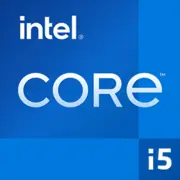Intel Core i5-12400T

인텔 코어 i5-12400T: 컴팩트하고 에너지 효율적인 시스템을 위한 완벽한 선택
2025년 3월
2021년 말에 출시된 인텔 코어 i5-12400T 프로세서는 성능과 에너지 효율성 사이의 균형을 중시하는 사용자들에게 여전히 유효한 선택입니다. 새로운 세대의 CPU가 출시되었음에도 불구하고, 이 모델은 낮은 TDP와 컴팩트한 시스템에서 안정적인 작동 덕분에 여전히 인기를 끌고 있습니다. 이 칩이 누구에게 적합하고 어떻게 조립에 통합할 수 있는지를 자세히 알아보겠습니다.
1. 주요 사양: 타협 없는 하이브리드 아키텍처?
알더 레이크 아키텍처와 인텔 7 공정
i5-12400T는 2021년에 발표된 알더 레이크 아키텍처를 기반으로 하며, 인텔의 첫 대규모 하이브리드 디자인입니다. 하지만 상위 모델(i5-12600K 등)과는 달리 이 프로세서는 Efficient-cores (E-cores) 없이 6개의 Performance-cores (P-cores)만 포함되어 있습니다. 이는 작업 관리를 단순화하지만 다중 스레드 성능을 제한합니다. 인텔 7 공정(10nm Enhanced SuperFin)은 좋은 에너지 효율성을 제공하며 TDP는 35W입니다.
주파수 및 캐시
P-cores의 기본 주파수는 1.8GHz이며 터보 모드에서 최대 4.2GHz에 도달합니다. 이와 같은 주파수 범위는 유휴 상태에서 에너지를 절약하고 부하 시 급속히 성능을 높일 수 있습니다. L3 캐시 용량은 18MB로, 이는 애플리케이션의 반응성을 개선합니다.
통합 그래픽
내장 GPU인 인텔 UHD 그래픽스 730은 오피스 작업, 4K 비디오 시청 및 덜 요구하는 게임(Minecraft나 CS:GO의 낮은 설정 등)에 적합합니다. 최신 AAA 게임을 위해서는 디스크리트 그래픽 카드가 필요합니다.
성능
- Geekbench 6: 2048 (싱글코어) / 7476 (멀티코어).
- i5-12400 (T 없는 버전)와 비교할 때 멀티코어 성능 차이는 약 15%로 올랐지만, 에너지 소비는 거의 절반으로 줄어듭니다.
2. 호환 가능한 마더보드: LGA 1700 소켓 및 칩셋 선택
이 프로세서는 LGA 1700 소켓을 사용하며, 600 시리즈와 700 시리즈 칩셋을 지원합니다:
- H610 — 예산형 선택지. 기본 조립에 적합하지만 PCIe 4.0 및 USB 포트에서 제한적입니다. 예시: ASUS Prime H610M-E ($90-110).
- B660/B760 — 최적의 선택. DDR4/DDR5, PCIe 4.0 및 USB 3.2 Gen2 지원. 예시: MSI PRO B760M-A WIFI DDR4 ($130-150).
- H670/Z690/Z790 — i5-12400T에는 과도한 사양으로, 이 칩은 오버클럭을 지원하지 않습니다. 최고 사양 CPU에서만 업그레이드에 적합합니다.
중요! 일부 700 시리즈 마더보드 (예: Z790)를 사용할 경우 Alder Lake와의 호환성을 위해 BIOS 업데이트가 필요합니다. 구매 전에 호환성을 확인하세요.
3. 메모리: DDR4 vs DDR5 — 무엇을 선택할까요?
이 프로세서는 두 가지 유형의 RAM을 지원합니다:
- DDR4-3200 — 더 저렴하지만 대부분의 작업에 충분합니다. 16GB (2x8) 세트는 $50-70에 구입할 수 있습니다.
- DDR5-4800 — 더 비쌉니다 (16GB — $80-100) 하지만 프로페셔널 애플리케이션 (렌더링, 코딩 등)에서 5-10%의 성능 향상을 제공합니다.
조언: 오피스 PC 및 미디어 센터에는 DDR4를 선택하세요. DDR5는 요구가 높은 소프트웨어가 필요한 워크스테이션에만 적합합니다.
4. 전원 공급 장치: 얼마나 많은 와트가 필요할까요?
TDP가 35W인 이 프로세서는 전원 공급 장치에 대한 요구가 적습니다:
- 디스크리트 그래픽 카드 없는 시스템: 300-400W의 파워서플라이면 충분합니다 (예: be quiet! Pure Power 11 400W, $60).
- NVIDIA RTX 3060 수준의 그래픽 카드와 함께: 500-600W 전원 공급 장치가 권장됩니다 (Corsair CX650M, $80).
중요! 낮은 TDP에도 불구하고, 80+ Bronze 이상의 인증을 받은 전원 공급 장치를 선택하세요. 이것은 안정성과 효율성을 보장합니다 (85% 이상).
5. i5-12400T의 장단점
장점:
- 에너지 효율성: 미니 PC 및 패시브 냉각 시스템에 적합합니다.
- PCIe 5.0 및 DDR5 지원 (미래 지향적).
- 저렴한 가격: $150-180 (신품, 2025년).
단점:
- E-cores 없음 — 멀티 스레드 성능이 Ryzen 5 7600에 비해 떨어집니다.
- 통합 그래픽 성능이 AMD Ryzen 5 5600G보다 약합니다.
- 오버클럭을 지원하지 않습니다.
6. 사용 시나리오
- 오피스 작업 및 웹 서핑: 수십 개의 탭과 오피스 애플리케이션을 쉽게 처리합니다.
- 미디어 센터: HDMI 2.0을 통한 4K HDR 디코딩.
- 가벼운 게임: GTX 1660 Super 수준의 GPU와 결합하면 Fortnite나 Apex Legends에서 60 FPS를 제공합니다.
- 홈 서버: 낮은 전력 소비와 가상화 지원.
실제 사례: 사용자가 i5-12400T 기반의 HTPC를 Silverstone ML05 케이스(4.5리터)에 조립했습니다. 시스템은 조용히 작동하며 유휴 상태에서 25W를 소비합니다.
7. 경쟁 제품과 비교
- AMD Ryzen 5 5600G (2021): 더 나은 그래픽(Vega 7)을 제공하지만 Geekbench 6의 싱글코어 성능은 1580입니다. 가격: $130-160.
- AMD Ryzen 5 7600 (2022): 성능 높음 (싱글코어 — 2250) 하지만 비쌉니다 ($200-220)그리고 DDR5를 요구합니다.
- 인텔 코어 i5-13400T (2023): 멀티코어 성능이 10-15% 향상되지만 가격은 더 높습니다 ($190-210).
결론: i5-12400T는 예산 세그먼트에서 우위를 점하며, 특히 에너지 절약이 우선인 경우에 더욱 그렇습니다.
8. 조립 팁
- 쿨러: 박스 쿨러로 충분하지만 완전한 조용함을 원한다면 Noctua NH-L9i를 선택하세요 ($50).
- 케이스: Mini-ITX (예: Cooler Master NR200) 또는 컴팩트 Micro-ATX.
- 저장 장치: 반드시 SSD NVMe를 사용하세요 (예: Samsung 980 500GB, $60).
- 네트워크 옵션: 마더보드에 Wi-Fi가 없다면 PCIe 어댑터를 추가하세요 (Intel AX200, $25).
9. 결론: i5-12400T는 누구에게 적합한가?
이 프로세서는 다음과 같은 경우에 적합합니다:
- 오피스 PC — 낮은 전력 소비와 안정성.
- 홈 시어터 — 조용한 작동과 4K 지원.
- 컴팩트한 조립 — 최소한의 열 발산.
- 예산형 게임 시스템 — 디스크리트 그래픽 카드와의 조합.
왜 이 프로세서인가요? $150-180에 현대적인 아키텍처, DDR5/PCIe 5.0 지원 및 Windows 11과의 보장된 호환성을 얻을 수 있습니다. 게임에서 최대 FPS나 3D 모델 렌더링이 필요하지 않다면, i5-12400T는 3-5년 동안 합리적인 투자로 자리 잡을 것입니다.
기초적인
CPU 사양
메모리 사양
GPU 사양
여러 가지 잡다한
벤치마크
다른 CPU와 비교
소셜 미디어에서 공유하기
또는 링크로 소개하기
<a href="https://cputronic.com/ko/cpu/intel-core-i5-12400t" target="_blank">Intel Core i5-12400T</a>